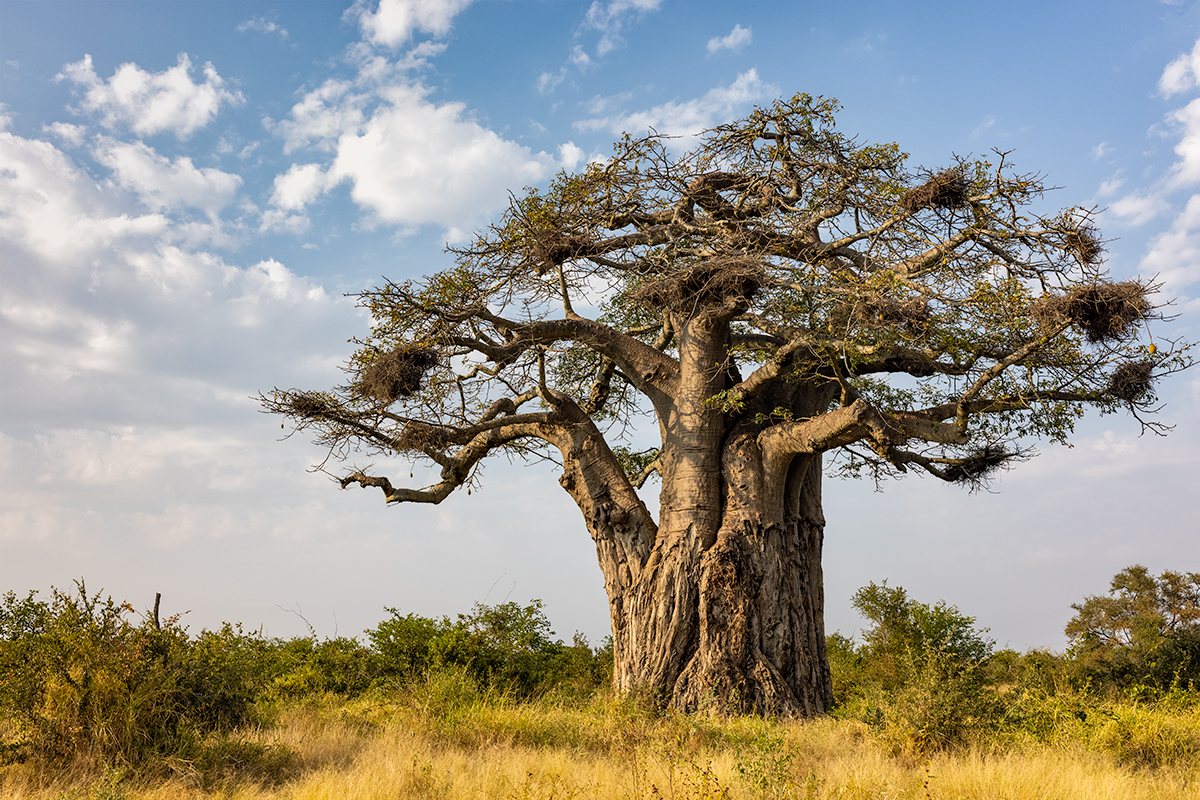
Baobab Tree (Adansonia digitata), Kruger National Park, Limpopo Province, South Africa.
Canon EOS R5 with a Canon RF 28-70 mm f/2L USM lens @ 28mm.
ISO 100. 1/25 sec @f/8. Aperture Priority exposure mode. EC=0 EV
We have recently returned from a trip to the Kruger National Park. It was my 70th visit to the park since I first went there in my early university days. It was also our final trip as a donor to the Parks Board. The donation, which dates back to 1988 when Mopani Restcamp was constructed, entitled us to 30days in donor accommodation each year for 30 years. The completion of the camp was delayed by construction difficulties and a devastating fire to the main building. The 2020 year was badly affected by the Covid-19 pandemic lockdowns, so our 30 years was extended to the end of June 2021.
It was in many ways a nostalgic trip, enjoying our well-sited accommodation in all the camps we stayed in – Shimuweni, Talamati, Mopani, Shingwedzi and Punda Maria. It made one think about all the changes that have occurred in the park over that time. Some of the changes have been good, but I do miss the “old days” when the park was more primitive and a lot quieter. We have mostly frequented the Northern region of the park. Whilst there is not the abundance of fauna found in the South, the tranquility and uniqueness of parts of the Northern section have always been a delight.
Unfortunately, the North has now been “discovered”. This has meant increasing numbers of visitors, many more game drive vehicles and campervans of various assortment. It has resulted in the north becoming more like the south as you are quickly surrounded by many vehicles if you are fortunate to be the first vehicle at a sighting.

A large herd of Elephant crossing a hazy Olifants River, Limpopo Province, Kruger National Park, South Africa.
Canon EOS R5 with a Canon EF 70-200mm f/2.8L IS III USM lens at 142mm attached with an EF/RF adapter.
ISO 800. 1/800sec at f/10. Exposure set manually.
Photographing in the Kruger Park.
I have always maintained that the KNP is not one of the best places for photography, especially when compared with Parks in East Africa and parts of Botswana and Zambia. Unable to leave the roads severely restricts you from getting optimal light angles for stunning images – not that there are no good opportunities for excellent sightings and if you are lucky, good images. In the Serengeti for instance, you can go “off road” and get good positioning for a shot or you are able to follow action that is taking place away from the public roads. The crowding of vehicles around a sighting makes photography a challenge. Kgalagadi suffers from much the same issue as it, too, is now very popular.
I had the opportunity on this trip to use extensively my new/newer Canon EOS R5 mirrorless and Canon EOS 1DX Mark III DSLR cameras. They are both truly excellent bodies with remarkable auto focus. See the image below and also [this blog].
It is much easier to get a take-off from the side than when the bird comes directly at you as in the blog mentioned above.

Lilac-breated Roller taking off from a branch of a tree. Kruger National Park, South Africa.
Canon EOS R5 with a Canon EF 70-200mm f/2,8L IS III USM lens @ 200mm attached by an EF/RF adapter.
ISO 800. 1/3200 sec @f/5.6. Exposure set manually.
Condition of the Bush
I have seldom seen the bush this dense and lush. Following good summer rains, the grass has recovered and grown high and the bushes and trees, particularly the Mopani bush areas, made you feel like you were driving in a forest. It was amazing to see. It made for beautiful drives as your eyes never tired of the lush green and start of the autumnal shades of yellows, oranges and reds. It did present photographic challenges to get a clear view of the fauna and therefore uncluttered images. Nevertheless, it was still a great experience. The usually dry river beds and gullies were filled with water and just added to the different atmosphere of the bush. See image below
As I did on my last visit to Kgalagadi [see blog], I tended to concentrate more on the environment than on the animals and birds, although we did have some great sightings of leopards and White Lions. There were also huge herds of Zebra and Wildebeest on the plains around Satara but even in the thicker Mopani bush. I have never seen that many during any previous visit. They are following their traditional migration from the Satara area. Some move south through the Lindanda plains towards Lower Sabie whilst, if there has been good rains in the north, some migrate to the Mopani area.
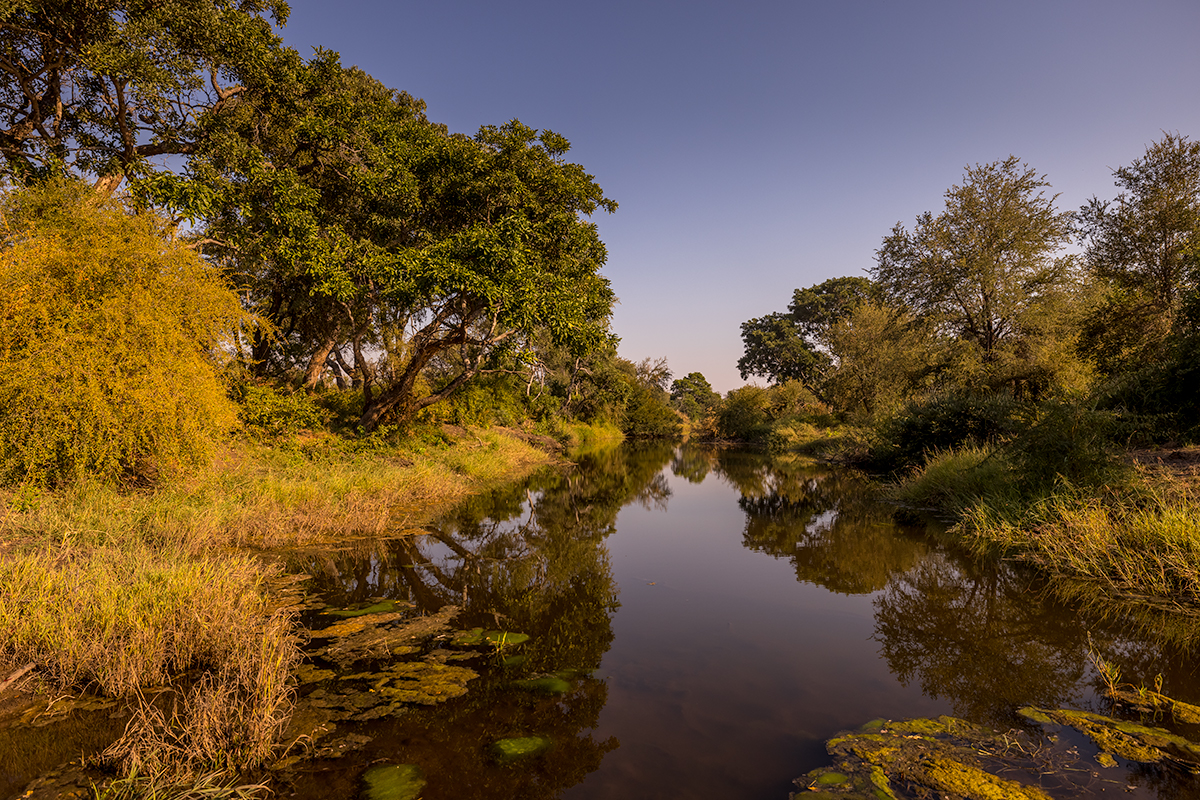
A gulley filled with water on the Dipeni Road to Shingwedzi. Kruger National Park, South Africa.
Canon EOS R5 with an RF 15-35mm f/2.8L IS USM lens at 22mm.
ISO 400. 1/1250 sec @f/5.6. Exposure set manually.
Because of fire danger during the winter months of the tall grasses and dense bush, controlled burning had commenced. Selected areas were being burned, resulting in fairly dense smoke which added to the drama of sunrises and sunsets.

Controlled bush fires. Kruger National Park, South Africa.
Canon EOS R5 with an RF 15-35mm f/2.8L IS USM lens at 21mm.
ISO 100. 1/200 sec at f/8. Aperture priority exposure mode.
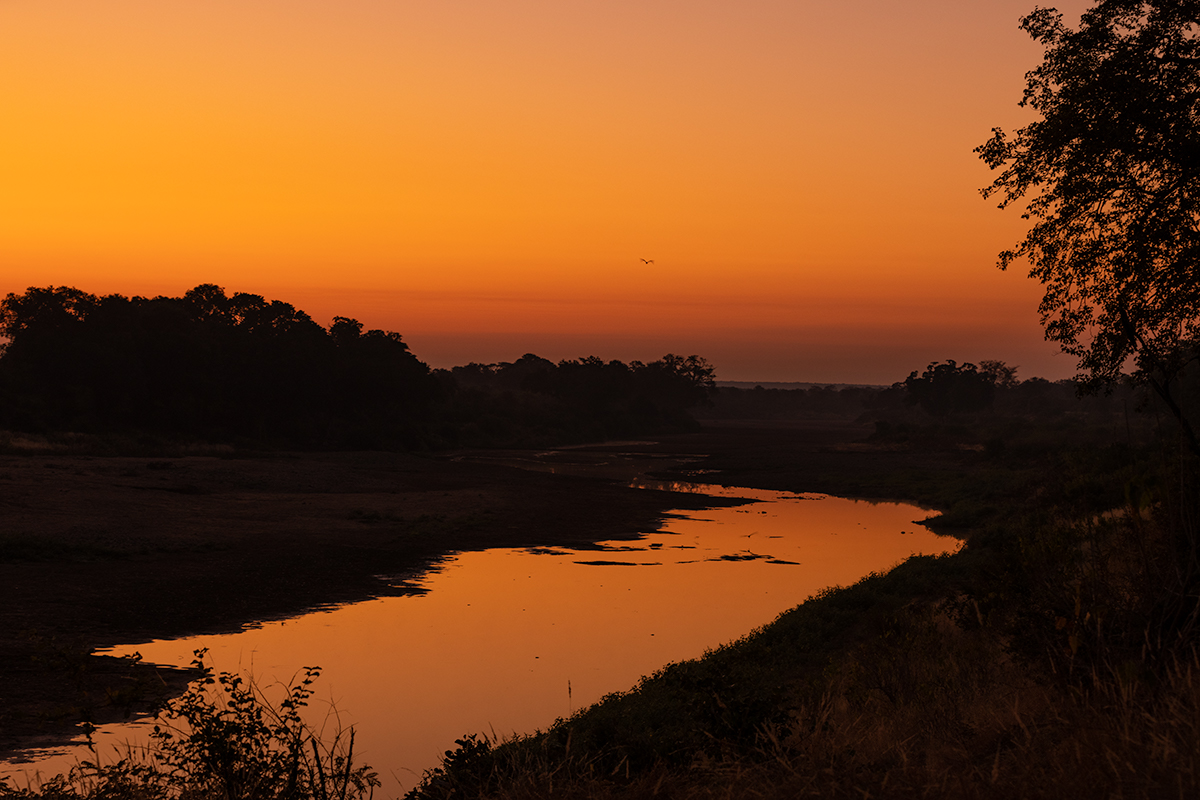
A smoke-hazed sunrise over the Shingwedzi River. Kruger National Park. South Africa.
Canon EOS R5 with a Canon EF 70-200mm f/2.8L IS III USM lens @ 75mm attached with an EF/RF adapter.
ISO 400. 1/13 sec. at f/8. Exposure set manually.

Another smokey sunrise. Shingwedzi Restcamp. Kruger National Park, South Africa.
Canon EOS R5 with Canon EF 70-200mm f/2.8L IS III USM lens at 95mm attached with an EF/RF adapter.
ISO 200. 1/160 sec. at f/11. Exposure set manually.
We very much enjoyed the bush itself, but we did experience many good sightings. We were fortunate to see White Lions near Orpen gate and also had good sightings of Leopards. The one we enjoyed most was also very unexpected. We were travelling back to Punda Maria after spending a quiet (gamewise) day at Pafuri. Up ahead in the tall grass on the side of the road we saw a small face peep out. We thought it might be a hyena but even that looked too big for what we had seen. By the time we had got to that point we couldn’t see it. After spending some time looking we suddenly saw a young leopard and realised that is what we had seen. It was quite panicky and was calling. We surmised that it may have been separated from its mother who was unseen somewhere on the other side of the road. I managed to get a clear image of it low down in a bush and then again peeping out of the grass. We were lucky to be the only ones there and decided to leave it be as another car was arriving to have a look. They later told us that the mother was on the other side of the road and was also calling. They were apparently re-united and scampered off into the thick bush.

Young Leopard, Kruger National Park, South Africa.
Canon EOS R5 with a Canon EF 200-400mm f/4L IS USM lens with built-in 1.4x extender @ 473mm.
ISO 400. 1/250 sec. @ f/5.6. Exposure set manually.
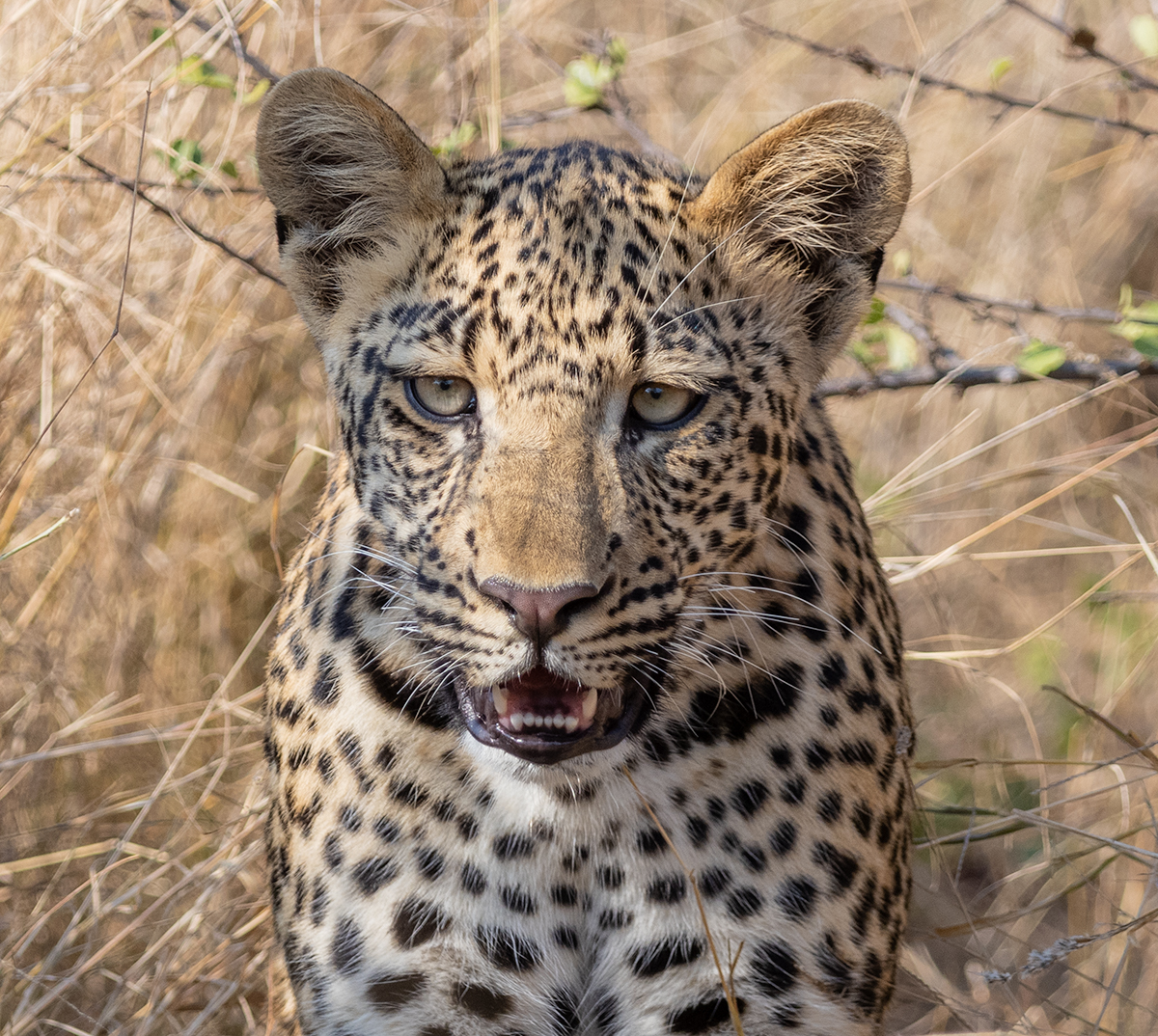
Young Leopard, Kruger National Park, South Africa.
Canon EOS R5 with a Canon EF 200-400mm f/4L IS USM lens with built-in 1.4x extender @ 403mm.
ISO 400. 1/800sec. @ f/5.6. Exposure set manually.
Seeing White Lions in the Kruger Park itself, was a first for me – after all these years! It was a good sighting as we were about the first vehicle to see them. Photographically it was not wonderful, because of the tar road and also the sun angle. However the sighting itself was very good. We saw them approaching the road, crossing and walking down the road and they seemed to want to hunt some wildebeest that were grazing nearby. They did look as if they were forming a team for hunting (there were some normal coloured lions with them) but never really seemed to be too enthusiastic. I was told that these lions were from the Birmingham pride that features very often on WildEarth®. I must say that next to normal coloured lions these look pretty insipid – like they don’t belong!

White Lion, Orpen area, Kruger National Park, South Africa.
Canon EOS 1DX Mark III with a Canon EF 200-400mm f/4L IS USM lens with built-in 1.4x extender @ 540mm
ISO 800. 1/2000 sec. @ f/5.6. Exposure set manually
Birds are not to be forgotten. I was surprised that there seemed to be a paucity of birds and this was especially in respect of water birds (mainly waders). Probably too much rain and there was little or no sand banks in evidence at waterholes or next to rivers.

Little Bee-Eaters (Merops pusillus), Kruger National Park, South Africa.
Canon 1DX Mark III with Canon EF 600mm f/4L IS II USM lens and 1.4x III converter.
ISO 800. 1/2000 sec @f/5.6. Exposure set manually.
Owls are my favourite birds. We were very lucky to have an African Barred Owlet sit in a small tree right next to our chalet in Talamati Bushcamp. It was out in the open and did not seem fussed about people being nearby. The image captured of this owl is actually from the back (light angle!) with the owl’s head turned 180°. It is heavily barred on the chest, but has interesting markings on its back. When we first saw it, my immediate thought was that it is a Pearl-spotted Owl. However I soon realised that it had different markings (no ‘eyes’ on the back of its head) and larger than a Pearl-spotted. Also the belly is spotted, not streaked.
From the small to one of the largest, in fact the heaviest flying bird in the country. A full grown male Kori Bustard could be the heaviest animal capable of flight in the world. Other than their size, they seem to be very ordinary. However, when you look closely at them, they have magnificent feather colouring. When they display during mating, they look spectacular. The image below the Barred Owlet is a Kori Bustard which is fairly common in the open drier northern regions of the park. We always see them on the Tropic of Capricorn loop near Mopani Restcamp. They are, however listed as NEAR-THREATENED.

African Barred Owlet (Glaucidium capense), Kruger National Park, South Africa
Canon EOS R5 with Canon EF 200-400mm f/4L IS USM lens with 1.4x built-in converter
ISO 1250, 1/400 sec. @f/5.6, Hand-held, Manual exposure

Kori Bustard (Ardeotis kori). Kruger National Park, South Africa.
Canon EOS R5 with Canon EF 200-400mm f/4L IS USM lens with built-in 1.4 extender @ 282mm.
ISO 800, 1/800 sec. @f/9, exposure set manually.

African Fish Eagle (Haliaeetus vocifer). Kruger National Park, South Africa.
Canon EOS 1DX Mark III with a Canon EF 600mm f/4L IS II USM lens and 1.4x III extender.
ISO 400, 1/3200 sec, @f/5.6. Exposure set manually.
We normally see pictures of Fish eagles catching “baited” fish. I found this particular pose interesting as it showed the back feathers in great detail. I had never noticed the small streaks in the white feathers – although that could be the rachis (or staff) of the feathers. I sometimes think that this should be our national bird because of its ever-so distinctive call.
One should always look closely at things and not just give them a cursory glance. I noticed this distinctive patterned dead tree stump. I captured an image and then noticed something moving in the top end of the stump. On closer examination it was a group of Bush Squirrels. A bit of useless information! – a family group of squirrels is called a dray and a non family group of squirrels is called a scurry. The following images show the point of looking carefully. The squirrels’ “nest” looked like a cut away depiction of their abode.

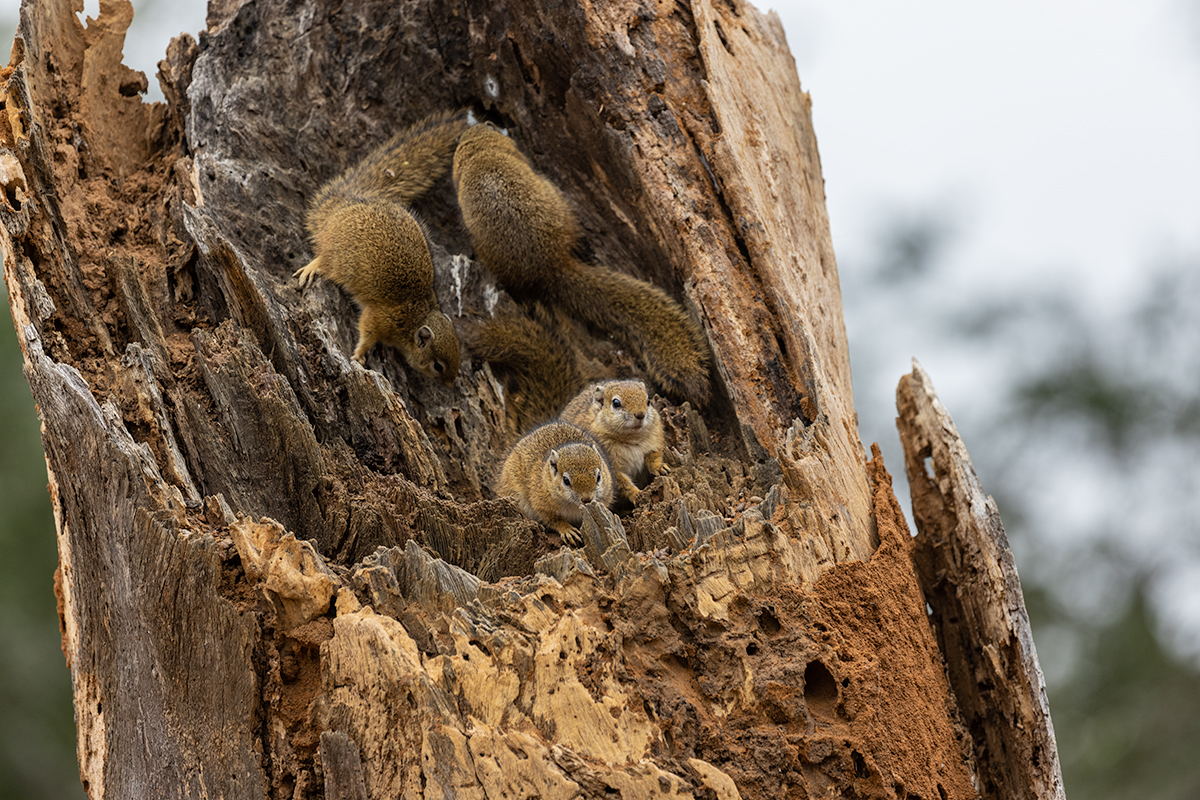
Stump:Canon EOS R5 with a Canon EF 70-200mm f/2.8L IS III USM lens @ 70mm. ISO 400, 1/200sec. @ f/5.6. Exposure set manually.
Group of Squirrels: Canon EOS R5 with a Canon 200-400mm f/4L IS USM lens with built-in 1.4 extender. ISO 400. 1/250 sec. @ f/5.6. Exposure set manually.
It was a great trip. Kind of nostalgic, but we will hopefully be back again next year. Just a few more images to remind oneself of the natural beauty you can experience in this wonderful wilderness.

Elephants walking out of the water. Grootvlei Dam, Kruger National Park, South Africa.
Canon EOS R5 with a Canon EF 200-400mm f/4L IS USM lens and built-in 1.4x converter.
ISO 400. 1/500 sec. @ f/11. Exposure set manually.

Impala Lily (Adenium multiflorum). Shingwedzi Restcamp, Kruger National Park, South Africa.
Canon EOS R5 with a Canon EF 70-200mm f/2.8L IS III USM lens attached with an EF/RF adapter.
ISO 400. 1/250 sec. @ f/7.1. Exposure set manually.
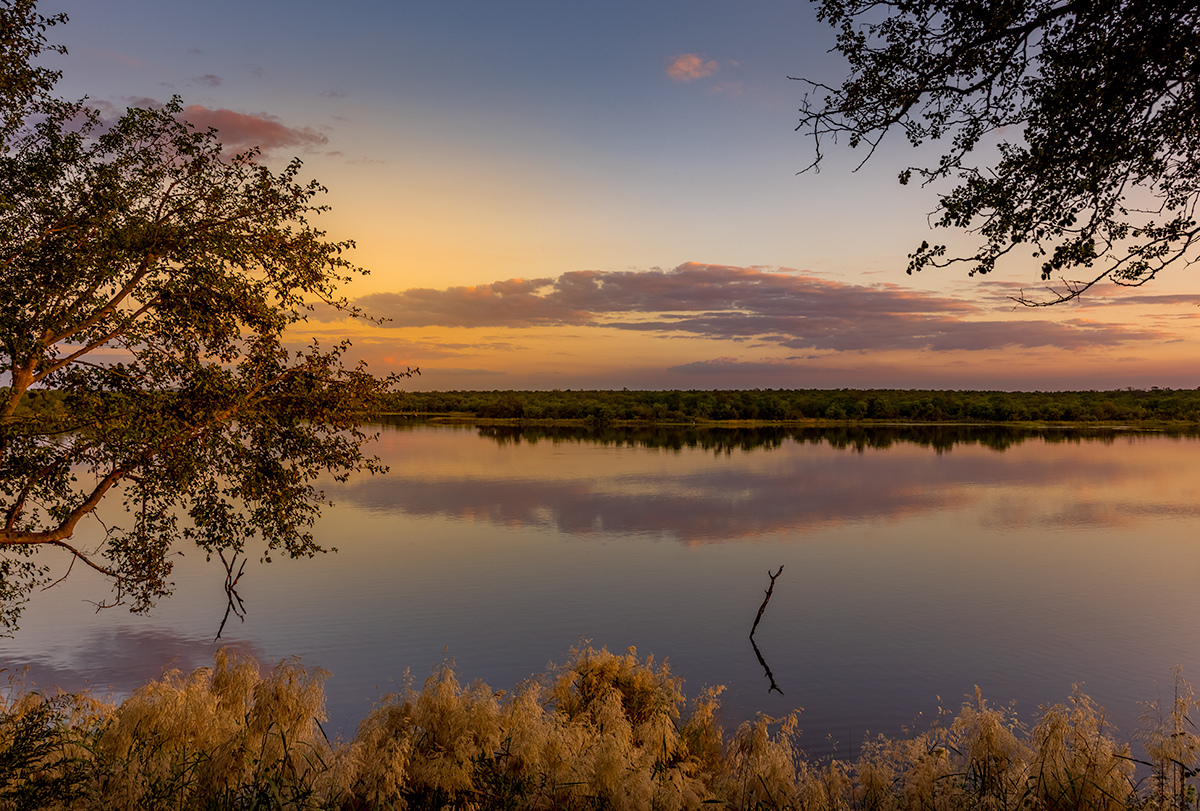
Pioneer Dam, Mopani Restcamp. Kruger National Park, South Africa.
Canon EOS R5 with a Canon RF 28-70mm f/2L USM lens @ 28mm.
ISO 100. 1/25 sec. @f/8. Aperture Priority exposure mode. EC = +2/3 EV
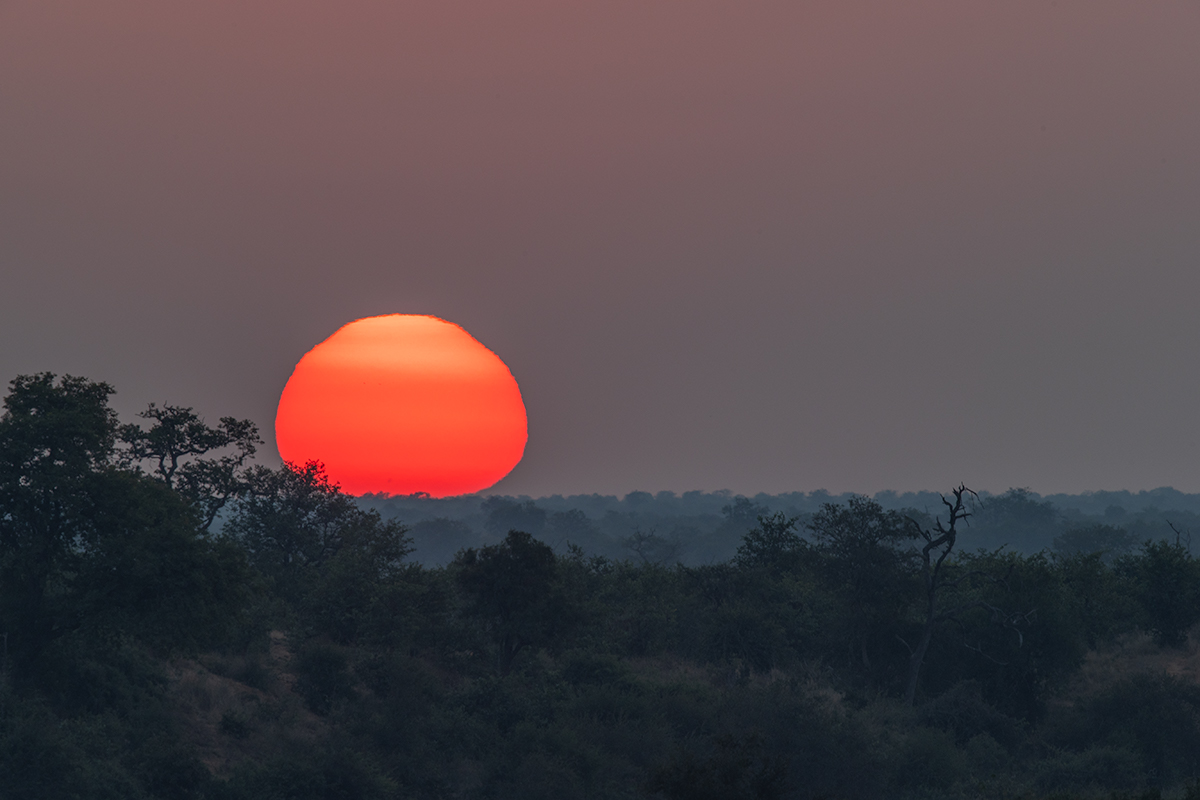
Sunset at Shingwedzi – strangely distorted by the smoke and heat haze from the veldfires. Kruger National Park, South Africa.
Canon EOS 1DX Mark III with Canon EF 600mm f/4L IS II USM lens and 1.4x III USM converter. Effective focal length 840mm.
Rig mounted on a Gitzo 1548 tripod and RRS BH-40 ballhead. Shutter triggered with an intervalometer
ISO 400. 1/100 @ f/11. Exposure set manually.

A real display of quality photography narrated by a pro. Thanks for sharing.
These images are amazing. Love reading your blog too. I can almost feel like I was with you!
John, your sentiments regarding the park echo mine. We were there for our last trip as donors from 8 -17 June, in Sirheni, Mopani and Satara and it was wonderfully nostalgic. Even though we make our drive part of the holiday it is a long way from Knysna and 15 days in a car is hard on an aging back.
Wonderful images as we expect and a great story.
Thanks for sharing.
We were very fortunate to be there when some of these incredible pictures were taken. Thank you for sharing these wonderful memories.
Many great memories made in Kruger, and we have been fortunate to share some with you. Your bird photos are amazing.